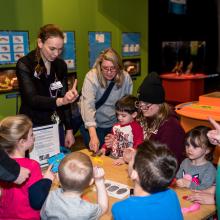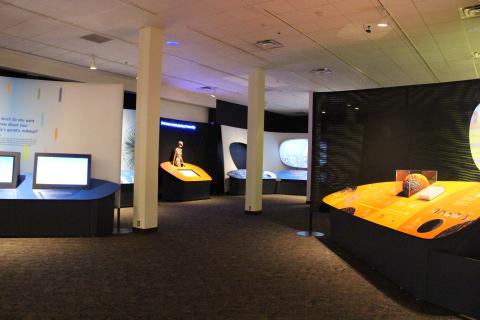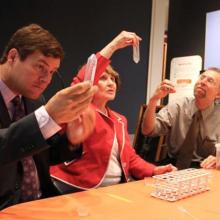The late Congresswoman Louise Slaughter was a great friend to the Rochester Museum & Science Center (RMSC) and the communities she served in New York’s 25th District. She was also one of the few scientists in Congress, and the only microbiologist, who championed the Genetic Information Nondiscrimination Act until it was signed into law in 2008 to prohibit discrimination by employers or health insurers based on an individual's genetic information.
Several years ago Congresswoman Slaughter approached the RMSC about hosting Genome: Unlocking Life’s Code, the traveling exhibition developed by the Smithsonian National Museum of Natural History and the National Human Genome Research Institute (distributed by Science North).
Genome: Unlocking Life’s Code is organized around three galleries where visitors can explore what a genome is, how it relates to medicine and health, and how it connects humans to all life on the planet.
The exhibition has several digital interactives and excellent content, and we recognized it would be stronger for older audiences than the young children we often engage as visitors. With that in mind, RMSC staff conceived of the Genome Discovery Center; a hybrid space incorporating unique RMSC collections with a facilitated hands-on activity library. Our vision was to develop an area where there would always be a highlighted experience of the day in addition to a library of kits that one could choose from and engage with either as an individual, or as a unit, at one of the gallery activity tables.
When thinking about hands-on activities that could engage a wide range of audiences with foundational concepts relating to genetics, as well as emerging related societal issues, we immediately turned to NISE Net's Building with Biology kit. RMSC was fortunate enough to be awarded a Building with Biology kit in 2016.
Our staff began by identifying the major content themes we wanted to engage around: forensics, agriculture, inheritance, and human medicine. Our vision for the visitor experience at the Genome Discovery Center included users being able to access and investigate kits without direct facilitation.
Even though the NISE Net kits are incredibly well vetted, we knew we still needed to do some testing so we could understand if any tweaks would be necessary. For the most part, very little changes were needed other than some new instructional materials to help visitors get started. Some of the activities we utilized included “Kit of Parts”, “VirEx Delivery”, “See DNA”, and “Bio Bistro”. Supported by a grant from the National Human Genome Research Institute, we also began investigating other activities we could include, such as using fingerprint analysis on balloons and the “Pipette by Numbers” activity from ASTC’s World Biotech Tour. As we looked at other NISE Net-related programming for inclusion, an interesting connection was made – geckos. We have utilized live geckos in our Nano programming for years, and one of our staff reminded us about the genetics of breeding leopard geckos and how we can follow genetic traits through phenotypic observation. Our four leopard geckos enclosures (high yellow, albino, striped, and albino-striped) became one of the most popular parts of the exhibition, and created a wonderful opportunity to support field trip studies around inherited traits.
Hosting Genome: Unlocking Life’s Code helped establish a more active relationship with the University of Rochester Medical Center (URMC). URMC is one of the nation’s leading academic medical centers, and includes: Strong Memorial Hospital, the Eastman Institute for Oral Health, the University of Rochester School of Medicine and Dentistry, and the University of Rochester School of Nursing. Roughly 3,000 people at URMC are dedicated to scientific research, studying common and rare illnesses, from cancer and heart disease to Parkinson’s and pandemic influenza. These efforts have led to therapies that have saved countless lives and improved human health locally, in the region, and across the globe. URMC researchers helped in developing some of our content for the Genome Discovery Center and have also visited the museum to engage with visitors around programming related to their work.
While preparing for the exhibit, we applied for the opportunity to host the NISE Net's newest Building with Biology forum on genetic editing and were again very excited to be selected as a participating site. We immediately knew URMC was the perfect partner to help us host the event. Forums provide an opportunity for community participants to engage in thoughtful conversations with scientists about important issues regarding the potential societal and ethical implications of a given scientific issue. URMC helped recruit synthetic biologists to participate in the discussion, as well as panelists to help us kick-off the event. As timing would have it, we were not able to host our forum event while we hosted the Genome exhibit, but the exhibit served as a wonderful precursor for engaging audiences in the topic, sparking interest in further discussion and allowing us to continue that discussion beyond the lifetime of a featured exhibit.
The conversations were engaging, respectful, and thought provoking. More than one person commented that he/she changed his/her mind about some aspects of genetic editing based on the conversations and diverse perspectives shared. The event was a wonderful experience for us. Participating scientists and non-scientists alike commented on how rich the experience was and when we would be hosting another.
We found that establishing a relaxed atmosphere early on in the experience was important for encouraging safe, comfortable, and open dialogue later. Rather than opening with a PowerPoint-style presentation, we began the event with our panelists and staff moderator in front of the audience on a comfy couch and chair, as if they were hanging out in a living room. The moderator started with a few prepared questions, and another staff member floated through the room to collect additional questions written on cards by audience members. It was only 15-20 minutes of a 2-hour event, but it was important to set the stage both in terms of background information and the open environment for dialogue.
Congresswoman Slaughter unfortunately passed away two months after we opened the exhibit she so passionately wanted us to bring to the people of Rochester. She was not able to experience it for herself, but we think she would be excited for the conversations we have started, and will continue to support, within our community.
To learn more about RMSC's Genome Discovery Center or about their experience hosting Genome: Unlocking Life’s Code, contact Calvin Uzelmeier, Director of Featured Content, Exhibition Support & Special Projects at [email protected].



